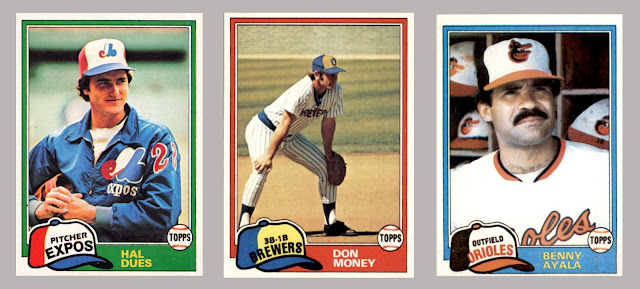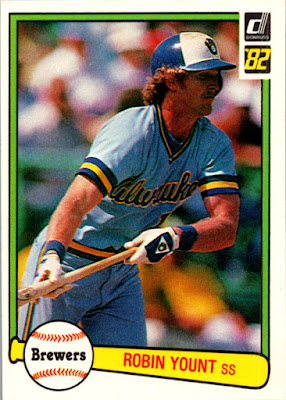Imagine you're a kid in early June of 1981. Summer vacation is so close,
you can taste it. You've been saving a couple of quarters every week and
buying packs of Topps baseball cards, chewing the gum, looking for your
favorite players, and having fun. And for the first time ever, there are even two other types of baseball cards out there—Fleer and Donruss—for you to try. It's baseball craziness. Life is good.
But then, on June 12, the Major League Baseball strike begins. No more baseball on TV. No MLB Game of the Week. Not even Mel Allen and This Week In Baseball.
It's not bad for the first couple of days. But a
few weeks go by, and now you're really feeling it. Even playing baseball down at
the local Little League field isn't quite the same. You still buy the occasional pack
of cards—after all, you have a set to complete—but when you open them, you find guys
like these inside:
Everyone is down in the dumps. It's just a total bummer.
I mean, school's
out, but what's the point when you can't watch guys like Mike Schmidt, Andre Dawson, Ozzie Smith, and Pete Rose doing their thing? You mope around for
another week or two, and then finally the good news arrives: The strike ends. And on August 9th, baseball is officially back—with the All-Star game, no less!
The day after the game, you race to the local
fields with your friends, and you've never swung the bat harder or run
the bases faster. Soon after, you're all trotting to the corner store
for some more packs of cards.
And now you're finding guys like these
inside:
Life is good again.
And looking back, I think the 1981 Topps design only helps with those good vibes. For example, compare the baseball caps these next six guys are wearing to the illustrated baseball cap in the lower left corner of each card.
That's a heck of an effort. The artists at Topps matched the colors and design
of each team's cap pretty accurately with the actual baseball caps that players were wearing—even
down to the little button on top! I was just a toddler in 1981, but if I were a few years older
and collecting cards, I think I would have been all over this design.
And looks aside, there's a lot of good action to be found in the photographs themselves.
Good cropping, too, don't you think? Not too tight, not too much empty space. And while it's true that the border colors often aren't matched to the team colors, I really don't mind. In fact, with the hats matching so well, it's probably better that the borders of
the card didn't also match.
Let's get to the uniforms now, because in 1981 they were all over the place.
Seattle
and Texas had some nice powder blues (I love that trident "M" on the
Mariners cap), and San Diego had their mustard yellow and brown. Pittsburgh
went with yellow pants, Houston had the tequila sunrise thing going on,
and the White Sox wore pajamas. Hooray 1980s!
Next up, the small but solid solid rookie class that 1981 Topps offers us.
Honorable mention to Tony Pena, Lloyd Moseby, and the Hubie Brooks/Mookie Wilson future stars card.
There are also some great team checklists in this set.
The Rangers used the Texas-shaped scoreboard very well on their card, while the Giants went for a fancy overhead look. However, there's one team checklist in the set that beats them all.
The Padres here give us the best argument for bringing back team checklists. Look at all those guys chilling out under the palms on the sunny San Diego coastline!
Other horizontal cards include a brief summary of the A.L. and N.L. Championship series, as well as the World Series.
Next, George Brett and Bill Russell show off the all-star banners, while Mike Schmidt gives us an example of a record breaker card. Note how the baseball cap theme continues on the championship card above and Schmidt's card below.
Now here's an example of a card back.
The black text on the pinkish background is okay. Better than some other years, for sure. And many cards received two cartoons, which is always a plus. Here are some that I enjoy.
(Astronomy = Butch Wynegar; Bicycle = Ed Ott; Screwball = Enrique Romo; Bodyguard = Lance Parrish; Billiards = Champ Summers; Amish Hat = Jim Kern; Hot Dog Vendor = Ed Glynn; Snake Hunting = Bob Davis; Pro Tennis = Barry Evans; Welder = Willie Hernandez)
Finally, a checklist, followed by the "Hit to Win" scratch-off game piece that came in every wax pack. You had a chance to win a bat, glove, baseball, and more!
And that's the 1981 Topps baseball set. I'd have to imagine it was a pretty fun set for the time period, despite the lack of baseball games in the middle of the season. Besides, once the strike did end, the abbreviated second half of the season and the playoffs were pretty great. (If you've never watched the Baseball's Seasons television series, which documents what happened in Major League Baseball season by season, I highly recommend watching the 1981 episode, and going to whichever season you want from there.)
What do you readers and collectors think about the 1981 Topps set? Share some thoughts in the comment section, and thanks for reading!





































